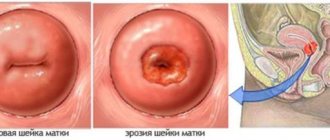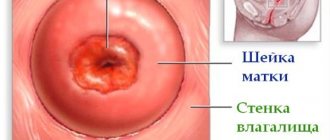Among diseases of the female reproductive system, erosive processes in the cervix are often diagnosed. Cervical erosion and HPV, oncological diseases of the female reproductive system are interrelated. The danger of papillomavirus lies in the absence of pronounced symptoms in the initial stages of development. Erosion is dangerous with the risk of degeneration into malignant tumors.
The human papillomavirus often provokes destruction of the cervix in women.
What causes uterine erosion?
Damage to the cervix can be caused by various sexually transmitted infections, trauma during sexual intercourse, childbirth, abortion and due to the use of an intrauterine device, chronic inflammatory processes, and hormonal disorders. A common cause of the development of erosive processes in the uterus (ectopia) is the human papillomavirus.
HPV as a cause of erosion
In the process of studying the development of malignant neoplasms, papillomavirus was discovered in more than 90% of cases as the cause of pathological processes. The virus has the ability to change and damage cervical cells. The danger is that it is very highly contagious and is often transmitted during sexual contact. But carriage of the virus does not yet indicate the presence of pathological processes. In addition, HPV often remains in a latent form and does not outwardly show any activity. The results of ongoing studies have shown that the pathogen completely leaves the body in approximately 60% of women 15 months after infection. The pathological development of the virus is influenced by the functioning of the human immune system.
Cervical papilloma and erosion at the same time
Erosion and HPV often accompany each other. The virus is most often transmitted during sexual contact. The pathogen can exist in the body for a long time without any manifestations. When immunity is weakened, its activation and the development of pathological processes are possible. Not all types of HPV lead to destructive processes in the cervix. HPV of high oncogenicity is considered dangerous.
HPV infection statistics
Erosion and HPV often occur together. Statistics also testify to this. What statistics on diseases are currently available?
- The virus is very common and occurs in 80% of people who have regular sex life;
- In 90% of cases of HPV detection in women, it can be quickly and effectively cured, without consequences for the body;
- In 10% of cases where HPV cannot be cured, progression to cancer is extremely rare, although there may be changes in cytology;
- The incidence of cervical cancer is 0.1%, regardless of whether HPV and erosion are present or not;
- HPV affects 10-12% of women worldwide. Moreover, 24% of this number is in Africa, 21.4% in Eastern Europe, and 16.1% in Latin America. These are indicators significantly higher than the world average, which is associated with a low level of sexual education, poor hygiene and frequent changes of partners;
- 45-50% of women 20-25 years old have HPV;
- In 64% of city residents, this virus is detected two years after the start of sexual activity.
- More than 70% of people under the age of 30 have been infected with HPV in the past or currently.
After 30 years, the infection rate decreases very sharply.
Risk of developing cancer
The most dangerous are HPV types 16 and 18, which pose a threat of developing cervical cancer.
The combination of two pathologies of the female reproductive system, such as HPV carriage and cervical erosive processes, increases the risk of developing oncological processes. Among all papillomaviruses, HPV 16 and 18 are considered the most dangerous. Cancer is most often detected with HPV 16. HPV 18 is in second position in the incidence of cancer. The main reason why viruses acquire an active form in the body is weakened immunity. The table shows the pathological changes caused by HPV.
| Pathological processes in the cervix | |
| Pathological changes | Description |
| Erosion | The process of displacement of columnar epithelium to the vagina while the structure and functions of the cellular epithelium remain unchanged. The difference in conditions between the cervical canal and the vagina leads to damage to the cylindrical cells, and damage occurs - erosion. |
| Dysplasia | Modifications in the structure of the squamous epithelium of the cervix, in which the structures, shapes of cells and the processes of their division are disrupted. In the transition section between the cervix and vagina, the columnar epithelium remains unchanged. |
| Cancer | This is a change in the structure and functions of epithelial cells, their unlimited growth and proliferation. |
Cervical dysplasia is a precancerous condition of the mucous membrane that lines the surface of the cervix. Pathology can only be determined during examination using a colposcope and during clarifying tests. There are 3 forms of cervical neoplasia (CIN):
- CIN I is a mild form characterized by minimal changes in the cervical epithelium;
- CIN II - moderate form of dysplasia, indicating an average degree of destructive processes;
- CIN III is a severe form indicating cervical cancer. It is in this form that HPV strains 16 and 18 are detected.
Cervical erosion in the early stages may not manifest itself in any way, but then a stench and bleeding appear.
Dangerous types of HPV
Dangerous types of papillomavirus that can lead to oncology are types 18 and 16. The latter occurs in 55% of cases. They are transmitted sexually. Although, there is a possibility of infection through everyday life through human household items.
The manifestations of these papilloma viruses are the same:
- First, papillomas appear on the genitals and thighs;
- They then spread throughout the body.
Visually, it is impossible to determine the specific type of HPV from the rash, which looks more like a cluster of nodules or flat spots. It is necessary to carry out diagnostic measures. After taking smears, a diagnosis is made and therapy is prescribed.
16 and 18 variants of papilloma viruses, penetrating human cells, bind to the chromosome. The result is a DNA mutation and the appearance of an oncological formation. First, the infection penetrates the cells of the uterus, and in the first stages the lower layer of the epithelium is deformed, which is how first-degree dysplasia appears. This is the first hint of cancer formation. In this case, the woman must take all measures to protect herself from cancer.
Malignant tumors form faster with HPV type 18. In this case, the tumor grows rapidly.
Diagnostics
A diagnostic examination for suspected erosive processes consists of examination using instruments and special devices, and laboratory screening to identify the degree of destructive processes in tissues and the causes of pathology. The examinations that a gynecologist prescribes for cervical pathologies are shown in the table.
| Examination for suspected cervical erosion | |
| Types of diagnostics | Characteristic |
| Gynecological examination | An examination by a doctor in a chair using mirrors allows you to visually assess changes in the structure of the cervix. After the examination, a decision is made about the need for additional diagnostics. |
| Colposcopy | Hardware examination with a colposcope, which allows you to magnify the area under consideration up to 10 times. During the examination, tests are carried out using medical solutions. |
| Carrying out a biopsy | Additionally, a colposcopy examination is performed, during which a suspicious area of damaged tissue is excised for laboratory tests. |
| Histological examination | Study of material obtained during a biopsy. |
| Cytological analysis by Papanicolaou test | Diagnostics by scraping the mucous membranes of the cervix to identify HPV cells and other cellular pathologies. |
| Ultrasound | Examination of the internal genital organs using ultrasound. |
| Laboratory screening for HPV | Conducting laboratory diagnostics to identify HPV, its type and concentration level. |
| Immunogram | Laboratory screening of the immune system. |
Treatment of cervical erosion due to HPV is aimed at fighting the virus and healing the damaged organ.
Types and which leads to cancer
There are many types of HPV.
All of them can be divided into three groups:
- Negatively affecting the skin.
- Causing pathologies of the genital organs.
- Damage to the mucous membranes of organs.
The following types lead to cancer:
- Skin cancer is caused by HPV types 2, 3, 5, 8, 9, 10, 12, 14, 15, 17, 19, 20, 36, 37, 46, 47, 50.
- Cancer of the genital organs, namely the cervix, is formed after HPV types 16, 18, 31, 33, 35, 39, 45, 51, 52, 54, 56, 66, 68.
- Head cancer occurs due to exposure to HPV types 2, 6, 11, 16, 18, 30.
How to treat cervical erosion due to HPV?
Cervical erosion caused by HPV needs to be treated in two ways. To do this, the fight against the development of viral pathology and the immediate cure of erosive processes on the cervix are carried out. Since it is almost impossible to get rid of the papilloma virus, treatment is aimed at strengthening the body’s immune forces, immunomodulators and vaginal suppositories are prescribed to reduce inflammation in the uterine cavity. The following methods are used for treatment:
| Treatment methods for cervical erosion | |
| Method | Description |
| Cauterization with special solutions | They are treated with various chemical solutions, for example Solkovagin. |
| Diathermocoagulation | Cauterization is carried out using high-frequency current. |
| Cryodestruction | Application of liquid nitrogen to the affected areas, which causes the inflamed cells to die. The method is used in the presence of large ulcers. |
| Laser vaporization | Removal of altered epithelium with a laser beam. The method does not leave scars and does not damage healthy tissue. |
| Removal using argon plasma | Under the influence of argon gas during its ionization, local heating and the process of coagulation of cervical tissue are carried out. |
Strong immunity, a healthy diet and lifestyle, and hygiene are the main rules for preventing cervical erosion.
Treatment
Timely treatment of erosion allows you to restore tissue immunity, improve your well-being and reduce the likelihood of other diseases.
Depending on the stage and extent of the lesion, various treatment methods are chosen:
- Drug treatment is carried out using medications. As a result of their intake, erosion degrades and complete recovery occurs (only in the early stages);
- Cryodestruction is freezing, strictly speaking, cauterization with liquid nitrogen. It is highly effective and low-traumatic;
- Radio wave treatment is carried out using a special device that specifically sends a radio wave to the erosion zone. At the same time, its healing and the formation of scar tissue are achieved;
- Laser cauterization is carried out using the directed action of a laser. A fairly effective method that is used frequently;
- Cauterization with electric current is prescribed less frequently. Processing occurs with currents of very high frequency;
- Thermal cauterization – cauterization using high temperatures. Currently, this method is almost never used;
- Chemical coagulation - cauterization of erosion through the use of chemicals. Also a little popular method at present.
Prevention
To prevent atypical processes in the uterus and HPV diseases, it is recommended to follow the following recommendations:
- maintaining a healthy lifestyle;
- adhere to a complete and balanced diet, a diet that includes B vitamins, vitamin A, folic acid and selenium;
- giving up bad habits, especially smoking;
- adherence to a daily routine, proper sleep;
- maintaining an active lifestyle with moderate sports activity;
- refusal of promiscuity, use of condoms;
- undergoing examination by a gynecologist twice every 12 months;
- conducting PAP screening for HPV, laboratory diagnostics for the presence of hidden infections with smears for cytology according to the doctor’s recommendations;
- vaccination against carcinogenic types of HPV, which is especially important in the absence of infection.
Erosion is not a death sentence. Timely diagnosis of pathology and implementation of appropriate measures to eliminate it leads to complete recovery. Prevention is a significant factor in preventing the development of complications and the subsequent degeneration of healthy tissue into cancerous tissue. Prevention of sexually transmitted diseases, a healthy lifestyle, and maintaining immunity at the proper level help prevent the development of destructive processes in the female internal genital organs.
How are the pathologies related?
Erosion and HPV very often occur together.
Due to the presence of cervical erosion in the body, the immune system malfunctions, which contributes to the sudden formation of HPV. Damaged mucosal cells during erosion are simply not able to resist HPV, as a result of which the active development of the disease occurs .
Erosion, like HPV, is transmitted through close skin-to-skin contact. After viruses enter the body, they have two development scenarios: firstly, if it is a weakened organism, the viruses are placed on the mucous membrane and penetrate into the blood; secondly, if the immune system is in order, then it will destroy it without giving pathology .
Indications for seeking medical help
Cervical erosion with HPV are similar in that there is no symptomatic picture in the early stages of both pathological processes. The appearance of certain signs is associated with weak immunity or the development of complications. Symptomatic picture, which is a reason to consult a doctor:
- discharge in the middle of the cycle, abundant, often with clots;
- pain in the lower abdomen, spreading to the lower back, mammary glands;
- painful and uncomfortable sensations during intimacy;
- the presence of an unpleasant odor in the vagina;
- painful, difficult urination.
Symptoms and stages of the disease
The virus may not manifest itself for a long time, remaining dormant in the body. When a favorable situation develops (a significant decrease in immunity, with erosion), it can already begin to manifest itself. There are four stages. All of them are observed in people infected with a tumor-causing virus.
- The first stage is characterized by a hidden course. Detection is possible only through special laboratory tests.
- The second stage is characterized by the appearance of new growths on the skin.
- The third phase is accompanied by changes at the cellular level.
- The fourth stage is mutation processes in cells, the development of a cancerous tumor.











